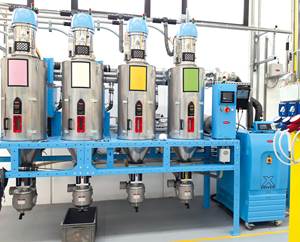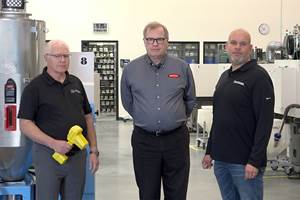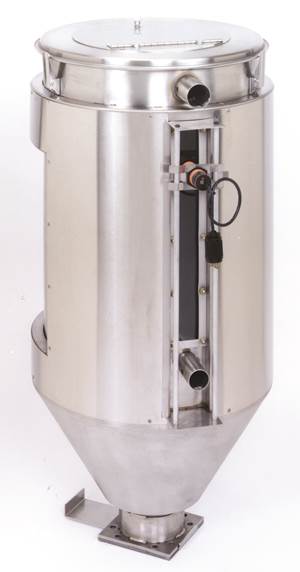Novatec Putting the ‘Smart’ In Resin Drying, Conveying
NPE2024: Machine builder gets ‘ludicrous’ by rewriting the rules for material drying and conveying.
Novatec’s NPE2024 display is reflective of the Baltimore-based machine builder’s strategy to write new rules in the critical areas of resin drying and conveying. It’s not writing new rules for the sake of writing new rules, but rather to introduce innovative technologies that break traditions and solve problems to make plastics processors more efficient and profitable
Drying has traditionally been a time-based process based on well-intended recommendations from material suppliers to accommodate the worst-case scenario — the longest time to guarantee absolutely dry resin. In a similar vein, suppliers have conventionally engineered plantwide vacuum conveying systems to accommodate the longest distance and the highest velocity the processor could ever need. Notes Novatec CEO Conrad Bessemer, “Both of our new systems are about using ‘finesse’ and moving past 50-year-old, etched-in-stone commandments for resin drying and conveying.”
For drying, Novatec’s DryerGenie game changer is to enable processors to dry based on material condition, not time. The DryerGenie features a resin-moisture analyzer situated below the receiver and directly above the drying hopper that measures incoming moisture level of the material and, depending on that reading, suggests the drying time (residence time) based on the dryer/drying hopper used. Inside the hopper, a drying process scanner measures temperature and intergranular humidity within the hopper, which is the moisture released through the drying process, and makes adjustment as needed to airflow, dewpoint and temperature.
Says Bessemer, “We see moisture measurement as a strategic direction for Novatec. For too long, the emphasis has been on only the generation of dehumidified dry air without the corresponding root cause emphasis on the actual conditions of the resin to be dried. By understanding the incoming resin moisture as well as the moisture given off within the hopper, Novatec has fundamentally revolutionized the drying process to a precisely measured and uniform process that minimizes effort, time and energy.”
Concerning conveying, most suppliers have historically also designed systems based on the worst-case scenario, according to Bessemer. This has meant “overpowering” the vacuum system to accommodate the longest possible conveying distance and/or the highest throughput. This approach, however, comes with consequences in cases where high speed and throughput are not required by the process, such as when where machines or other auxiliaries are closer to the vacuum source.
Bessemer elaborates, “Those consequences include high velocities, which are damaging to destination equipment in terms of product wear, especially with the increasing use of abrasive materials. Another issue is the fracturing of material within the lines or deformation caused by excessive heat caused by that high velocity. In addition, since most vacuum conveying systems designed for the ‘worst case’ then have to use higher line sizes, this makes them tough to use with minor accessory add-ons such as feeders or some blenders in typical resin handling systems.”
Over the years, suppliers have tried to address these issues with mechanical flow control systems to try to control that rate, but few have had the adaptability or ease of use to truly be practical in a typical plastics processing setting, Bessemer explains.
So Novatec has once again endeavored to rewrite the rules by using novel technology commonplace elsewhere and updating/modifying it for plastics. At the heart of the resin conveying rethink is a totally new machinery concept for vacuum conveying pumps. Often isolated because of their noise, these pumps provide the raw power to carry resin from multiple sources to multiple end-use destinations throughout the factory. But Bessemer says they’ve been traditionally engineered akin to the gas guzzlers of old — raw power sized for the worst possible case. Now, with using Novatec’s own IPM-SynRM motors — originally conceived to power electric vehicles efficiently — the company is able to achieve remarkable finesse in vacuum conveying pumps with speed ranges unheard of before to address the fundamental flaws of these juiced-up systems.
With the replacement of the fan-cooled induction motor, Novatec’s new Smart Pump can go down to incredibly low speeds which the company says conventional VFD systems couldn’t achieve. At the same time, they can be ramped up into what Bessemer refers to as “ludicrous speed modes” of up to a theoretical 150% when necessary, such as to help clear such common issues as line plugging caused by verticals.
This ability to “finesse” enables the system to automatically adjust for the pickup velocities but also be intelligent enough to slow down at destination to avoid pellet fracturing and abrasion. And it’s all done electronically, not through expensive, hard-to-operate mechanical adjustments that are not practical in the plastics processing industry, Bessemer notes. The pump has no belts or pulleys, enabling it to run much quieter than typical motors, which are measured at 90+ db. At the show, the Smart Pump will be running in the middle of Novatec’s booth at about 70 db.
The new pumps are rounded out by incorporating sensors that automatically alert to low lubrication levels and other service conditions pioneered by Novatec’s MachineSense group. Additionally, new sensors can adjust the pump automatically for changes in elevation in most areas as well as measure power use and detect flow anomalies in line flow. Everything is controlled by a modern state-of-the-art system that not only monitors the new pump systems but also the sensors and all the remote destination equipment such as blenders, feeders, dryers and receivers.
Says Bessemer, “For us at NPE2024, it’s about rethinking the basics of drying and moving resin to make plastic processors more efficient and, more than anything else, do so with minimum power, minimum resin loss and in the least amount of time. The realities of profit and loss in plastics processing is all about minimizing expensive resin losses and minimizing the time constraints in the process. These two new systems from Novatec — integrated moisture-controlled drying systems with the DryerGenie along with smart conveying with the Smart Pump IPM-SynRM motor — are prime illustrations of using modern technology to substantially change the design direction, efficiency, and economics of drying and conveying today.”
Related Content
PiovanGroup Rebrands, with Mostly Minor Name Changes
For the most part, subsidiary company names will remain, with slight modifications meant to enhance the Group’s identity.
Read MoreFinding Efficiencies in How Components Work Together
Auxiliary systems are vital to the proper functioning of a plastic processing line, and they can be a source of major cost and efficiency improvements.
Read MoreCaptive Molder Beefs Up Auxiliaries to Boost Quality, Consistency
SeeScan adds conveying, drying, feeding and chilling technologies to improve quality — and enhance employee safety — in production of its underground/underwater inspection systems.
Read MoreBozzelli’s Guide To Specifying a Dryer
Here's a list of 17 things to do when looking for new drying equipment.
Read MoreRead Next
People 4.0 – How to Get Buy-In from Your Staff for Industry 4.0 Systems
Implementing a production monitoring system as the foundation of a ‘smart factory’ is about integrating people with new technology as much as it is about integrating machines and computers. Here are tips from a company that has gone through the process.
Read MoreBeyond Prototypes: 8 Ways the Plastics Industry Is Using 3D Printing
Plastics processors are finding applications for 3D printing around the plant and across the supply chain. Here are 8 examples to look for at NPE2024.
Read MoreLead the Conversation, Change the Conversation
Coverage of single-use plastics can be both misleading and demoralizing. Here are 10 tips for changing the perception of the plastics industry at your company and in your community.
Read More











